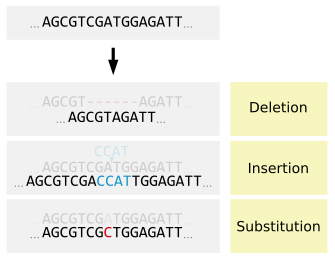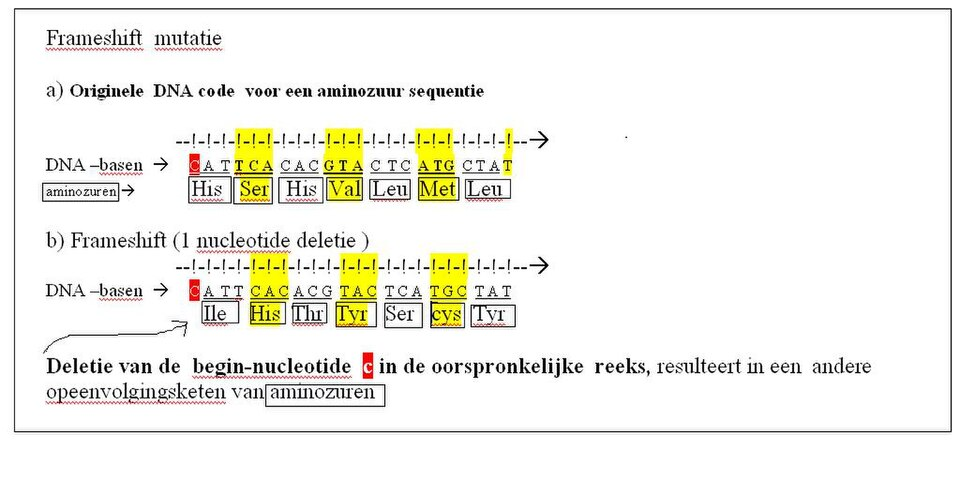OCR Specification focus:
‘Describe substitution, insertion and deletion mutations, and explain how changes can be beneficial, neutral or harmful by altering protein production and function.’
Gene mutations are changes in the DNA sequence that can alter protein structure or function, sometimes producing harmful, neutral or beneficial effects influencing evolution and health.
Types of Gene Mutation
Gene mutations occur when the sequence of bases in DNA is changed. These changes may affect a single nucleotide or a small section of a gene. Mutations can arise spontaneously during DNA replication or be induced by external factors such as radiation or chemicals (mutagens). The type of mutation determines how the genetic code and resulting protein are affected.

Illustration comparing substitution, insertion, and deletion mutations at the DNA level. The diagram emphasises how bases are replaced, added or removed, setting up downstream effects on codons and proteins. Labels are minimal and clear for first-pass recognition of each type. (No extra content beyond syllabus requirements.) Source.
Substitution Mutations
A substitution mutation occurs when one nucleotide base is replaced by another in the DNA sequence. This changes a single triplet (codon) within the gene, which may or may not alter the amino acid sequence of the resulting polypeptide.
Substitution mutation: A point mutation in which one nucleotide base in the DNA sequence is replaced by another.
Because the genetic code is degenerate (more than one codon can code for the same amino acid), some substitutions cause no change in the amino acid sequence, while others alter it.
Substitution mutations can be categorised as follows:
Silent mutation – the altered codon still codes for the same amino acid, so the protein remains unchanged.
Missense mutation – the altered codon codes for a different amino acid, which may change the protein’s structure and function.
Nonsense mutation – the altered codon becomes a stop codon, leading to premature termination of translation and a shortened, usually non-functional, protein.
An example of a missense mutation is found in the sickle cell allele of the haemoglobin gene, where one base change substitutes valine for glutamic acid, altering the protein’s properties.
Insertion Mutations
An insertion mutation occurs when one or more extra nucleotide bases are added to the DNA sequence. This can have a dramatic impact because it alters the reading frame of codons in mRNA during translation.
Insertion mutation: A mutation in which one or more nucleotides are added to the DNA sequence, potentially shifting the genetic reading frame.
When the reading frame is altered, every codon downstream of the insertion is changed. This is called a frameshift mutation, leading to a completely different amino acid sequence and a non-functional protein.

A clear schematic of a frameshift mutation demonstrating how an insertion/deletion shifts the reading frame so that subsequent codons and amino acids are changed. This directly supports why many frameshifts yield non-functional proteins. (Minor Dutch labelling appears but does not add extra content.) Source.
If the number of inserted bases is a multiple of three, the reading frame is not shifted, but extra amino acids are added, still possibly altering protein shape and function.
Deletion Mutations
A deletion mutation occurs when one or more nucleotide bases are lost from the DNA sequence. Like insertion, this can also cause a frameshift mutation if the number of deleted bases is not a multiple of three.
Deletion mutation: A mutation in which one or more nucleotides are removed from the DNA sequence, possibly altering the reading frame.
Frameshift mutations resulting from deletions usually produce non-functional proteins because they drastically change the amino acid sequence and often introduce premature stop codons.
Molecular Consequences of Mutations
Alteration of mRNA and Translation
Mutations change the sequence of bases in the DNA, which is transcribed into messenger RNA (mRNA). During translation, this altered mRNA sequence directs the incorporation of incorrect amino acids or premature termination of synthesis.
Effects on Protein Structure and Function
The primary structure of a protein (its amino acid sequence) determines its secondary, tertiary, and quaternary structures. Mutations can therefore disrupt:
Folding – leading to misfolded or unstable proteins.
Active sites – in enzymes, affecting catalytic activity.
Binding regions – altering receptor or transport protein function.
These molecular effects determine whether the mutation is beneficial, neutral, or harmful.
Effects of Gene Mutations
Beneficial Mutations
Some mutations increase an organism’s fitness, offering an advantage that may be favoured by natural selection.
Examples include:
Mutations in bacteria conferring antibiotic resistance, allowing survival in drug environments.
Mutations in humans providing malaria resistance through altered haemoglobin structure.
Beneficial mutations drive evolutionary change by creating new alleles that improve survival or reproduction.
Neutral Mutations
Many mutations have no effect on phenotype or fitness. Neutral mutations occur when:
The change occurs in a non-coding region of DNA.
The mutation produces a synonymous codon due to genetic code degeneracy.
The amino acid change does not affect protein function or structure.
Although neutral, such mutations contribute to genetic diversity within populations.
Harmful Mutations
Some mutations are deleterious, reducing fitness or causing disease.
Harmful effects can result from:
Production of a non-functional protein, leading to metabolic disorders.
Loss of regulation in gene expression, causing uncontrolled cell division or cancer.
Disruption of essential pathways due to enzyme malfunction.
Examples include:
Mutations in the CFTR gene, leading to cystic fibrosis.
Mutations in tumour suppressor genes such as p53, contributing to cancer.
Mutations as a Source of Genetic Variation
Despite their risks, gene mutations are a key source of genetic variation, which underpins natural selection and evolution. In sexually reproducing organisms, these new alleles are reshuffled through meiosis and fertilisation, maintaining diversity in populations.
Mutations that arise in somatic cells affect only the individual, while those in gametes can be passed to offspring, influencing evolutionary processes over generations.
Factors Affecting Mutation Rate
Mutation rates vary among organisms and are influenced by both intrinsic and extrinsic factors:
DNA replication errors that escape repair mechanisms.
Exposure to mutagens, such as ionising radiation or chemical agents.
Cellular repair efficiency, as efficient systems can correct more mutations.
Cells possess DNA repair enzymes that identify and correct errors, maintaining genome integrity. Failure in these systems can increase the accumulation of mutations.
Summary of Key Mutation Outcomes
Substitution – may be silent, missense or nonsense; possible minor to major effects.
Insertion and deletion – often cause frameshifts, usually producing non-functional proteins.
Beneficial mutations – can drive adaptation and evolution.
Neutral mutations – contribute to genetic variation without changing phenotype.
Harmful mutations – can cause genetic diseases or loss of function in essential proteins.
FAQ
Mutagens are physical or chemical agents that alter DNA structure or interfere with replication. They increase the likelihood of base mispairing or strand breaks.
Examples include:
Ionising radiation (e.g. X-rays, gamma rays) – causes breaks in DNA strands.
Ultraviolet radiation – induces formation of thymine dimers, distorting the DNA helix.
Chemical mutagens such as nitrous acid or base analogues – modify nucleotide bases, causing incorrect pairing during replication.
Cells can repair damage through DNA repair enzymes, but excessive exposure can overwhelm these systems and permanently alter base sequences.
Mutation “hotspots” occur where the DNA sequence or structure makes errors more likely.
Repeated or palindromic sequences can misalign during replication, leading to insertions or deletions.
High GC content areas may form stable secondary structures that hinder polymerase activity.
Actively transcribed genes are more exposed because their DNA is unwound more often, increasing vulnerability to damage.
Protective mechanisms like chromatin compaction and proofreading help minimise mutations in vital regions such as housekeeping genes.
Cells possess several repair mechanisms to maintain genome stability:
Mismatch repair identifies mispaired bases after replication and removes the incorrect nucleotide.
Base excision repair removes chemically altered bases such as uracil or oxidised guanine.
Nucleotide excision repair removes bulky distortions like thymine dimers.
After excision, DNA polymerase fills the gap using the complementary strand as a template, and DNA ligase seals the backbone. Failures in these systems can lead to inherited conditions such as xeroderma pigmentosum.
Yes. Occasionally, a base substitution alters an amino acid in a way that enhances enzyme activity or protein stability.
For instance, a mutation might:
Increase the enzyme’s affinity for its substrate.
Strengthen hydrogen bonding within the protein, improving structural stability.
Enable a receptor to respond more efficiently to a signalling molecule.
Although rare, such beneficial mutations can provide a selective advantage and may become more common in a population through natural selection.
Non-coding regions include promoters, enhancers, and silencers that regulate transcription.
A mutation here can:
Alter transcription factor binding sites, changing how efficiently RNA polymerase initiates transcription.
Disrupt enhancer-promoter communication, reducing or increasing gene expression.
Affect non-coding RNAs that regulate mRNA stability or translation.
Thus, even though these mutations don’t alter the protein’s amino acid sequence, they can modify how much protein is produced, influencing phenotype and disease risk.
Practice Questions
Question 1 (2 marks)
State and explain the difference between a substitution mutation and an insertion mutation in terms of their effect on the genetic code.
Mark scheme:
1 mark for correctly describing substitution mutation: One base is replaced by another in the DNA sequence.
1 mark for correctly describing insertion mutation: An extra base is added, causing a frameshift that changes all downstream codons.
Question 2 (5 marks)
Explain how different types of gene mutations can lead to beneficial, neutral or harmful effects on an organism. Use examples to support your answer.
Mark scheme:
1 mark for recognising that mutations alter the base sequence of DNA and can change the amino acid sequence of a protein.
1 mark for describing beneficial mutations, e.g. a mutation that gives bacteria antibiotic resistance increases survival.
1 mark for describing neutral mutations, e.g. a silent mutation due to genetic code degeneracy has no effect on the protein produced.
1 mark for describing harmful mutations, e.g. a deletion or nonsense mutation can result in a non-functional protein causing disease such as cystic fibrosis.
1 mark for clear explanation linking the effect on protein function to the organism’s phenotype or survival, e.g. altered active site affects enzyme activity, influencing health or adaptation.

